Con l'avvento dell'era 5G, sta emergendo la tecnologia degli elettrodi secchi sovrapposti e si prevede che la domanda di nastri in PTFE crescerà in modo significativo
xinst27 febbraio 2020
Con l'avvento dell'era 5G, sta emergendo la tecnologia degli elettrodi secchi sovrapposti e nastri in PTFE crescerà in modo significativo
Mentre la Cina avanza al livello di leader globale nel campo delle batterie al litio e 5G, le aziende cinesi (come Shenzhen Xinst Technology Co., Ltd) have also expanded the market space in the development and application of advanced materials. Later PTFE tape demand will be in high-frequency copper clad laminates, RF cables, and base stations for 5G communications. The field of antenna filters has ushered in substantial growth; the introduction of Tesla's ultra-high nickel cathode material based on dry electrode technology for lithium battery technology has not only brought about technological changes in the lithium battery industry, but has also brought huge demand for PTFE binders. the amount.
01、Polytetrafluoroethylene (PTFE): the "king of plastics" in fluoropolymers
Il fluoropolimero si riferisce a un tipo di polimero in cui gli atomi di idrogeno collegati al legame CC nel polimero sono completamente o parzialmente sostituiti da atomi di fluoro. Poiché gli atomi di fluoro hanno una bassa polarizzabilità e la più forte carica negativa, il raggio di van der Waals più piccolo, quindi rispetto ad altri polimeri convenzionali, i fluoropolimeri contenenti gruppi CF hanno spesso molti vantaggi, come eccellente resistenza al calore, resistenza chimica, resistenza agli agenti atmosferici, resistenza ai solventi , Bassa infiammabilità, alta trasmissione della luce, basso attrito, basso indice di rifrazione, bassa energia superficiale, bassa igroscopicità e super resistenza all'ossidazione, ecc.
Based on the excellent performance of fluoropolymers, it plays an important role in the transformation and improvement of traditional industries such as the automotive industry, chemical industry, power industry, food industry, aerospace and construction. From the perspective of downstream applications:
1) The chemical industry is the largest consumer area of fluororesin, and it mainly uses the excellent performance of fluororesin for corrosion resistance, high and low temperature resistance;
2) Followed by the machinery industry, fluororesins are processed into various parts;
3) The amount of fluororesin consumed by the electronics and electrical industry is also relatively large, mainly by using the excellent dielectric properties of the fluororesin;
4) The amount of fluororesin consumed by the coatings industry is also increasing, mainly due to its chemical and physical stability and self-cleaning. In addition, textiles, cooking utensils, medical equipment, etc. also consume a certain amount of fluororesin.
In addition to the traditional application fields, with the development of various emerging application scenarios, fluoropolymers and fluororesins have been widely used in strategic emerging fields such as high-end equipment manufacturing, electronic information, new energy, energy conservation and environmental protection.
02、Relatively concentrated global PTFE tape production capacity
European and American countries have a first-mover advantage in the development and utilization of fluoropolymers. In 1995, global PTFE production capacity was about 65,000 tons, of which 23,500 tons were in Japan, 21,600 tons were in DuPont in the United States, 80,000 tons in Hearst, Germany, and 0.7 was in British ICI Company. 10,000 tons, and Ausimont in Italy 0.5 million tons. At this time, the domestic production of 1,000-ton units in Jinan Chemical Plant and Fluorochemical Plant has just started, and domestic PTFE production capacity accounts for only about 8% of the world. Since then, as the domestic fluorine chemical industry has accumulated for many years, the technological monopoly of bulk and low-end fluorine chemical products has begun to break through, relying on the abundant fluorite raw material resources in Zhejiang, Fujian and other regions, as well as the advantages of adjacent downstream end markets, including PTFE. The included fluorochemical industry is gradually shifting from overseas to China. As of 2019, domestic PTFE production capacity is approximately 140,000 tons, accounting for more than 40% of the global total production capacity.
03、The 5G era opens, dry electrodes accelerate lithium-ion technology reform, and PTFE enters its growth stage again
In the mobile communication base station, the printed circuit board (PCB) copper-clad board is the core substrate of the printed circuit board, and the copper-clad board (CCL) is made of petroleum wood pulp paper or glass fiber cloth as a reinforcing material, impregnated with resin, single-sided or Sheet material made of copper foil on both sides covered by hot pressing. CCL material is the basic material for the production of PCBs. It is mainly used for making PCBs, and plays the role of interconnection, insulation and support for PCBs. PCBs processed from high-frequency copper-clad substrates are widely used as the most basic connection devices in the 5G field. At present, 4G communication field PCBs widely use epoxy glass cloth-based copper-clad laminates with Df values above 0.01, while 5G fields are mainly micron and millimeter wave applications. For high-frequency and high-speed dielectric constants and dielectric losses Higher requirements are usually required for low dielectric constant resins with a Df of less than 0.005. PTFE, as the polymer material with the lowest dielectric constant found so far, has a Df value of 0.002 or less, and exhibits excellent dielectric properties in copper clad laminates. performance.
The development of 5G communications will also bring continuous growth in filter demand. At present, the major 5G filters used by major communication equipment vendors are mainly metal cavity filters. Many metal PTFE components are used in metal cavity filters to support them. , Insulation, heat insulation, generally through PTFE rod processing or direct compression molding, 5G communication metal cavity filter is more miniaturized, the internal structure will be more, the amount of PTEF is also greater than when 4G.
Oltre alla sua applicazione in laminati rivestiti in rame ad alta frequenza, cavi a radiofrequenza e filtri per antenne di stazioni base, il PTFE come mezzo isolante è anche ampiamente utilizzato in vari connettori nel campo 5G. Con la divulgazione e l'applicazione della tecnologia 5G e di altri campi del PTFE La crescente ricerca sulle applicazioni guiderà ulteriormente la domanda del mercato per PTFE.


